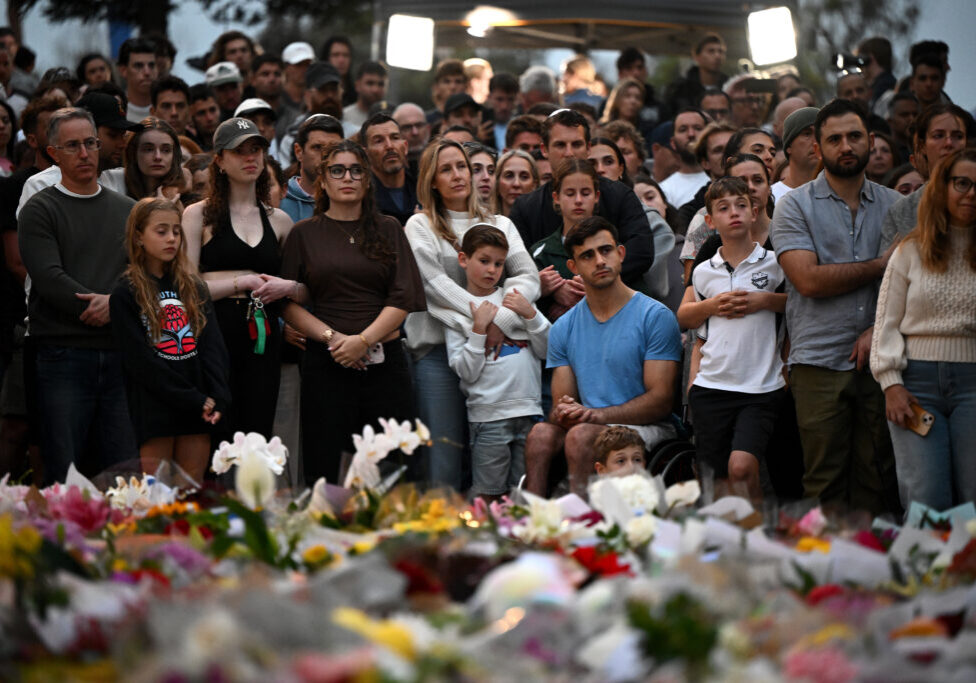Australia/Israel Review
Noted and Quoted – March 2020
Mar 5, 2020 | AIJAC staff

SBS Caught Mapping
An SBS TV “World News” (Jan. 29) report on US President Donald Trump’s peace plan included four grossly inaccurate maps showing purported changes in the territory at the heart of the century-old dispute between Israelis and Palestinians. They seemed to be based on a series of ahistorical propaganda maps of “shrinking Palestine” widely used in pro-Palestinian circles.
The first map titled “1917 Balfour Declaration” included the territory of what is today Israel, the West Bank and Gaza shaded in yellow.
The second map, called “1947 UN Partition Plan”, showed the map coloured red and yellow.
The third map, “1948 Israeli Independence”, showed large amounts of red and much smaller sections of yellow.
In the last map, “2020”, the ratio of red to yellow was even more pronounced.
While the colours were not labelled, the clear implication was the yellow areas were shrinking Palestinian lands, engulfed by Israel represented as red.
Reporter Helen Isbister’s voiceover confirmed this, stating that, “It comes more than a century since colonial power Britain approved the establishment of a national home for Jews in Palestine, with Palestinian territory shrinking significantly since then, including when the State of Israel was proclaimed in 1948, and with further reductions to come.”
The maps and voiceover claims about “shrinking Palestinian land” are simply grossly inaccurate.
Regarding the first map, until late 1917, the Middle East – apart from Egypt – were parts of the Ottoman Empire and the borders of Lebanon, Palestine, Syria, Iraq and Jordan did not exist. These were drawn up by Britain and France and only finalised in the early 1920s.
Until Britain was granted the Palestine Mandate by the League of Nations in 1922 with the directive to implement the Balfour Declaration and create a national home for Jews, there had never been a Palestinian state, let alone a consensus on where or what “Palestine’s” borders were.
In fact, until June 1922, the official map of British Mandate Palestine included what is now Jordan.
Moreover, implying that all of the mandate was “Palestinian territory” in this context is wrong. Britain controlled these areas politically and most of the land was state land, although individual Arabs and Jews obviously owned a minority of the land privately.
Regarding map two, the report did not tell viewers that the 1947 Partition Plan map never materialised because Palestinian Arab leaders rejected it and, in collaboration with the surrounding Arab states, went to war to prevent its implementation.
Regarding map three, viewers should’ve been informed that at the end of the 1948 war, Gaza and what is called the West Bank were occupied by Egypt and Jordan respectively. None of it was or became “Palestinian land” as the map and voiceover implied.
The final map with the lowest amounts of yellow purports to show a disappearing Palestine but is in fact the areas of the West Bank Israel handed over to the Palestinians in the 1990s. These areas are actually the first genuine “Palestinian land” – in the sense of land under the political control of a Palestinian governing authority – that have ever existed in history.
Further, if any of Israel’s three offers since 2000 to create a Palestinian state had been accepted, the map of Palestine in 2020 would have included territory approximating the 1948 map.
Planting and planning
AIJAC’s Colin Rubenstein wrote the Trump Administration peace plan “could plant the seeds of hope for a new fruitful dialogue between Israelis and Palestinians.”
He said, “it clarifies that both Trump and Netanyahu support a two-state outcome” which is “important as both… have been criticised for expressing reservations about Palestinian statehood in the past.”
The plan’s positives, Rubenstein wrote, include “overturn[ing] the conventional wisdom that peace requires Israel to return… to the 1967 Six-Day War” armistice lines, and “a new proposal for how… both Israel and the Palestinians [can] have a capital” in Jerusalem.
He said the proposal offers less territory than past offers demonstrating that Palestinian “historic rejections” have “real enduring costs in the long term,” Age/Sydney Morning Herald (Jan. 30).
Return to Kazak-stan
Former PLO envoy to Australia Ali Kazak’s analysis of the Trump Administration peace plan in the Age (Feb. 6) included wild claims and calls for a one-state solution.
Kazak suggested the “absence of Palestinian input” into the plan “shows the extent to which US Middle East policy has been hijacked by Israel”. Of course, the Palestinian Authority refused to offer any input into the plan.
He claimed that “the aims of the Zionist Organisation, from its founding father Theodor Herzl to Israel’s fathers Chaim Weizmann and David Ben-Gurion to its current leader Benjamin Netanyahu… has been to colonise all of historical Palestine” and “ethnically cleanse the Palestinians.”
This is just untrue. Herzl’s 1902 novel Altneuland (“The Old New Land”), imagining a future Jewish state, envisioned Arabs having an important and valued role.
Weizmann supported Britain’s first proposal to partition the country into Jewish and Arab states in 1937 which would’ve created a tiny Israel.
In a letter to Britain’s Foreign Secretary Ernest Bevin in 1947, Israel’s future first prime minister David Ben-Gurion endorsed “the establishment of two States, one Jewish and the other Arab.”
Kazak also accused Herzl of writing that Zionists should “try to spirit the penniless population across the border” – a claim based on misrepresentation of a passage from Herzl’s diary in which he was clearly talking about a proposal to create a temporary Jewish refuge in an area of Argentina.
Inverting history, Kazak implied Israel ruined the 1947 Partition Plan, and took more land than it was entitled to. Of course, it was the Arab leadership that smashed the plan and went to war, creating the Arab refugees and a loss of territory.
Kazak’s claim that UN General Assembly Resolution 194 gives Palestinians an “inalienable” right of return to territory that became Israel is also wrong.
Resolution 194, passed in 1949, is not legally binding. The words “right of return” are not part of it and any return was conditional on both the willingness of returnees to live in peace and practicality.
Kazak also said, “to this day Israel does not have defined borders.”
Israel has fixed borders with all those neighbours that have made peace with it i.e. Jordan and Egypt. Lebanon, Syria and the Palestinians refuse to make peace and so temporary armistice lines are in place.
Rabin’s vision
Veteran journalist Tony Walker panned the Trump Administration’s peace plan, writing, “In all of this, the year 1995 should be regarded as the reference point…That was the year a Jewish zealot assassinated Prime Minister Yitzhak Rabin. The so-called peace process effectively died that day,” Canberra Times (Feb. 3).
The Canberra Times ran a response from AIJAC’s Allon Lee (Feb. 6), which noted that Rabin presented his vision for a “permanent solution” to the Israeli Parliament shortly before his death and that it shared remarkable similarities to Trump’s peace plan.
Rabin envisaged “a Palestinian entity… which is less than a state… The borders of the State of Israel, during the permanent solution… will not return to the 4 June 1967 lines.”
Jerusalem, he promised, would remain united under Israeli control, and “the security border of the State of Israel will be located in the Jordan Valley, in the broadest meaning of that term.”
One-sided
ABC current affairs coverage of the Trump Administration peace plan overwhelmingly favoured critical voices over those who saw merit in it.
Analyst Caroline Rose told ABC Radio National “Saturday Extra” (Feb. 1), “The Palestinians don’t necessarily get much out of this deal, nor is it within their interests to sign on to it.”
Host Geraldine Doogue asked Rose, “Does this plan, in effect, say there will be an independent Palestinian state, like if Netanyahu accepts this?” Rose said it is “incredibly ambiguous”. It isn’t ambiguous, it just requires the Palestinian Authority to meet its obligations.
On ABC Radio National “Religion & Ethics Report” (Feb. 5), US academic David Myers said, if implemented, the plan “really entails the end of Israel as a Jewish and democratic state.”
Host Andrew West said to Myers, “You have always been, if you like, a good-faith critic of Israel. And for many years, you have tried to resist this idea of the comparison between modern Israel and apartheid South Africa.” Myers concurred, but both West and Myers were being disingenuous.
In Dec. 2014, Myers readily agreed with the proposition put to him during an interview with West that some people say Israeli control over the West Bank has led to “creeping apartheid.”
Disaster zone
On ABC Radio National “Breakfast” (Jan. 29), academic Samer Shehata denounced the peace plan as “a disaster for the Palestinians and for their cause and for justice, for that matter. And it’s not a real peace proposal,” and doubted the claims it will double Palestinian territory.
Shehata also said the Old City is “an area that has been in Palestinian hands for centuries”. Wrong – until Britain captured Jerusalem in 1917, the Ottoman Caliphate ruled the city.
The next day, former Palestinian MP Mustafa Barghouti told “Breakfast” the plan mirrored apartheid South Africa and Palestinians are “losing about 40 percent of the land that is West Bank that is assumed to be the land of the future Palestinian state.”
Barghouti is talking nonsense. The Palestinian Authority would get land almost equivalent to all of the West Bank and Gaza under the plan.
“Breakfast” host Fran Kelly told viewers the program would include “a reaction from Israel to Donald Trump’s peace plan” on Feb. 3. This never occurred.
Glass totally empty
ABC Middle East correspondent Eric Tlozek was extremely critical of the plan’s proposals for Jerusalem, telling ABC Radio “PM” (Jan. 29), “It doesn’t offer the Palestinians anything that they want regarding Jerusalem. And it’s also misleading to say the Palestinians can have a capital… in eastern Jerusalem because that capital would be outside Israel’s security barrier. You know, the wall and fences that the… UN found 15 years ago were illegal… it offers them the chance to build a capital in an area that is nowhere near the historic capital, that are in suburbs, that frankly have problems with law and order and infrastructure and access roads. And, you know, they’re not nice places… So it doesn’t offer them any greater access to the holy sites or control of the holy sites than they have now.”
In fact, as per the decision made by the Israeli government in 1967, Islamic trusts already have full control over the Al-Aqsa Mosque/Temple Mount in the Old City of Jerusalem.
And as for the wall, it was constructed to stop Palestinian terrorists crossing over into Israel from the self-rule areas of the West Bank, and has been extremely successful. If real peace were achieved, it will presumably be moved or removed. Meanwhile, perhaps the US plan’s US$50 billion in funds could help improve those “not nice places.”
Missing piece
A Daily Telegraph (Jan. 28) report on Israeli PM Binyamin Netanyahu’s trip to Washington DC for the release of the Trump Administration peace plan included a number of naïve statements.
The story said, “The Palestinians have not been consulted on the much-trumpeted deal and have pre-emptively rejected the US proposal.”
In fact, the Palestinian Authority boycotted the process.
The article also said, “Netanyahu has been flirting with plans to annex the Jordan Valley [which] could… extinguish any hope of creating a viable Palestinian state.”
There is no reason why annexing the Jordan Valley would extinguish hope of creating a viable Palestinian state other than because the Palestinian Authority says so. Few Palestinians live in the area and it does not prevent territorial contiguity.
12 years overdue
The Daily Telegraph’s Feb. 13 story on a meeting between Palestinian President Mahmoud Abbas and former Israeli PM Ehud Olmert said the Palestinian leader would negotiate, but only on the basis of the latter’s 2008 offer.
It claimed, “talks between the pair broke down in 2008 amid legal trouble for the Israeli leader and an Israeli operation in the Gaza Strip.”
Talks broke down when Abbas refused to meet or respond to then PM Olmert’s offer to create a Palestinian state that included land equivalent to 100 per cent of the West Bank, all of Gaza and shared sovereignty over Jerusalem. This occurred before the Gaza war in Dec. 2008 and Jan. 2009.
Bright spots
On ABC News Radio (Jan. 29), former Australian Ambassador to Israel and current Liberal MP Dave Sharma downplayed suggestions the US peace plan’s announcement was linked to Israel’s or the US’s election campaigns.
On ABC TV 24 (Jan. 29) AIJAC’s Tzvi Fleischer was able to mitigate some of the claims made by Palestinian activist Samah Sabawi who appeared alongside him.
Fleischer noted that the Palestinian Authority has refused to attend peace talks for five years and boycotted this latest effort too.
Sabawi was asked by the host if it is “a bit rich to reject a plan which Palestinians had an opportunity to help draft but chose not to?” but responded with a list of alleged grievances that had nothing to do with the question.
Fleischer contextualised why Trump’s plan offers less land than previous deals, noting the need for Israel to maintain security to prevent Hamas launching terror and rocket attacks from the West Bank into Israel in a repeat of what has played out in Gaza since Israel withdrew in 2005.
Another welcome voice was the Zionist Federation of Australia’s Bren Carlill on the ABC website (Jan. 30), who said, “Palestinians get far less than what they want, and far less than what Israel has previously offered, as a direct result of decades of rejectionism.”
Australian views
Commenting on Trump’s plan, the Australian offered some vital history (Jan. 30), noting that “In 2000, Bill Clinton brokered a deal in which Ehud Barak, the Israeli prime minister at the time, offered an independent state in all of Gaza and 95 per cent of the West Bank, with Israeli territory to be relinquished for the remaining 5 per cent. Palestine Liberation Organisation leader Yasser Arafat, unwilling to give up the struggle against Israel, rejected it. Palestinians followed up with a four-year suicide-bombing campaign against Israeli civilians. Twenty years on, the conflict remains seemingly intractable.”
Columnist Jennifer Oriel said (Feb. 3), “the Trump administration challenged the illusion of peace crafted by the UN. He noted that despite more than 700 UN General Assembly resolutions and 100 Security Council resolutions related to the Israeli-Palestinian conflict, no peace had been found… [The plan] challenged the denial of Israel’s sovereignty over key parts of Jerusalem and made the case for the state to expand its territorial boundaries on the basis of national security.”
Many unhappy returns
US-based Iran analyst and recent AIJAC guest Behnam Ben Taleblu told SkyNews “Outsiders” (Feb. 09) that, on the anniversary of the 1979 Islamic revolution, Iran’s leadership is trying to “signal strength” but “it’s actually signalling weakness.”
He cited as an example the delays and failures by Iran to launch satellites which require the same technology used in intercontinental ballistic missiles and which “many in the West believe…is cover” for the missiles program.
“So, every time the regime is trying to signal strength it is actually signalling failure. And this echoes really what a lot of Iranian people believe, which is that it’s 41 years too many,” he said.
Inflated claims
A Daily Telegraph (Jan. 27) news brief on Israel hitting targets in Gaza – including an arms factory – in response to balloons carrying explosives sent from the Hamas-controlled Strip into Israel, was given the inflammatory headline “Revenge for balloon raid.”
Unlike Gaza’s terror groups which launch indiscriminate attacks aimed at Israeli civilians – which is a war crime – Israel plans surgical strikes to avoid Palestinian civilian casualties. The Herald Sun ran an identical report with the more appropriate headline of “Raids reply to bombs”.
Lost in the Amazon
In the Daily Telegraph (Jan. 23), NSW Jewish Board of Deputies Chief Executive Vic Alhadeff called on online retail giant Amazon to stop selling copies of The Protocols of the Elders of Zion.
Alhadeff accused Amazon of “contributing to this increase in anti-Semitic incidents which has become a global phenomenon, including here in Australia” and said the retailer must be “profoundly aware of the inflammatory and fraudulent content of this vile book. ”
Tags: Australia, Media/ Academia






